Inclusion of up to 300 grams per kilo will not compromise production performance
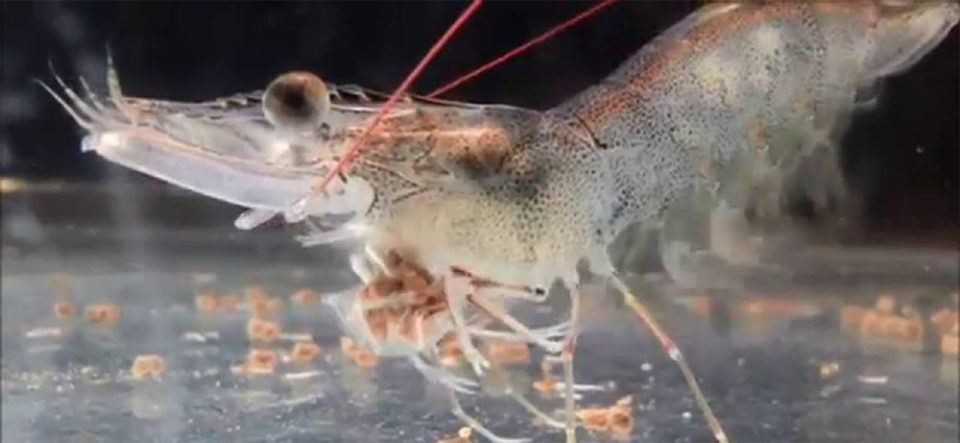
Feeds usually represent 40 to 60 percent of the total production costs in semi-intensive and intensive shrimp aquaculture, so reducing feed-related costs is important for further industry growth.
Aquafeed costs can be lowered by reductions in fishmeal inclusion with alternative ingredients such as plant and animal protein sources. Lower-cost ingredients like rendered animal byproducts – blood meal, poultry byproduct meal and meat and bone meal – have successfully replaced all or part of the fishmeal in shrimp diets, with significant feed cost savings.
The qualities of these feedstuffs vary depending on raw ingredient quality and the processing systems. Animal-based meals have numerous advantages – such as a high percentage of crude protein and low carbohydrate levels – and they do not have antinutritional factors that decrease phosphorus, iron and zinc bioavailability.
Plant proteins are additional protein sources for aquafeeds. Nutritionally, a combination of plant protein sources can totally or partially replace marine meals such as fishmeal. Soybean meal is one of the most widely used plant-based proteins for fish and shrimp aquafeeds because of its protein level, acceptable amino acid (AA) profile, suitable availability, and affordable price. Much research has been carried out with soybean meal singly or in combination with other ingredients to replace fish meal in shrimp feeds. As soybean meal is also in high demand we need to continually evaluate alternative combinations of protein sources.
Several yeast-based products have been used in fish feeds with good results. An important consideration when supplementing high dietary levels of yeast is the development of AA imbalances, especially for methionine and lysine, which are typically limiting in plant-based formulations. Currently, available data on yeast products in commercial crustacean feeds is limited. And grain distillers dried yeast (GDDY) – a coproduct obtained from the wet milling of corn kernels by the bioethanol industry – is another ingredient recently introduced. Available data on its performance in shrimp feeds is limited.
Therefore, the objectives of our study – with cooperation and support from Archer Daniels Midland Company (ADM) and HATCH funding, and with the help of many at E.W. Shell Fisheries Research Station – were to evaluate the response of Pacific white shrimp (Litopenaeus vannamei) to increasing levels of GDDY as replacement of solvent-extracted soybean meal (SE-SBM), and to evaluate the shrimp response with/without lysine supplementation in practical diets when cultured in clear water systems. This article summarizes the original publication (doi: 10.1111/jwas.12267).
Experimental setup
We conducted two growth trials at E. W. Shell Fisheries Research Station in Auburn (Alabama, USA). In trial 1, five experimental diets were prepared containing increasing levels of GDDY (0, 50, 100, 150, and 200 grams/kg of diet) as a replacement of SE-SBM. In trial 2, three experimental diets were formulated to have increasing levels of a commercial GDDY (0, 200, 300 grams/kg of diet), and two additional diets were prepared to supplement commercial lysine to diets 200 and 300 GDDY in order to determine if lysine was limiting. All experimental diets were prepared to be isonitrogenous and isolipidic (approximately 350 grams/kg crude protein with 80 grams/kg lipid), replacing SBM by GDDY and balancing with fish oil and corn gluten meal.
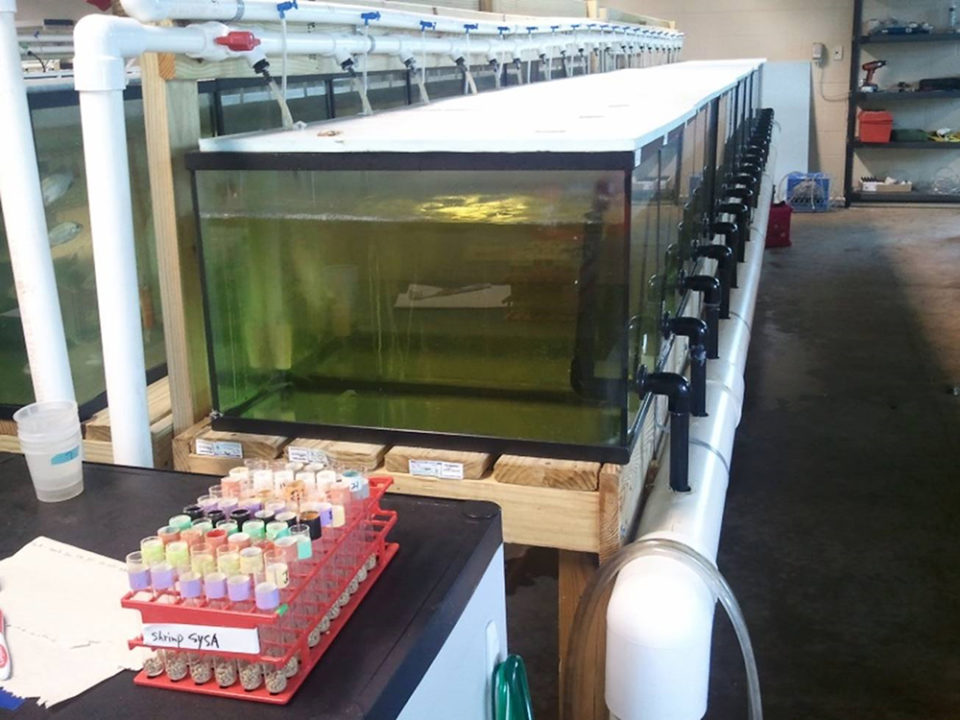
An indoor recirculating culture system was used, with culture tanks, sump tank with biological filter, sand filter, circulation pump, and supplemental aeration. Each tank was covered with a plastic lid to prevent shrimp losses from jumping. Tanks were filled with reconstituted seawater, and water was circulated throughout the culture system at a rate of 3.6 L/min. Five experimental diets were randomly assigned to four (trial 1) or three (trial 2) replicated tanks per treatment.
Pacific white shrimp postlarvae (PL) were sourced from a commercial hatchery in Florida reared in a nursery tank (570 L) and fed a commercial feed (400 g/kg protein and 90 grams/kg lipid) by automatic feeder until reaching appropriate size. These juvenile shrimp were selected to a uniform size (1.90±0.10 grams and 0.40±0.01 grams, initial weight in trials 1 and 2, respectively) and stocked into 15 or 20 square tanks (0.6 × 0.6 × 0.5 meters, 180 L volume) under a recirculating system at a density of 10 shrimp per tank.
In each trial, test diets were fed four times daily with two feedings in the morning and afternoon over an 8-week period. Shrimp were counted every week to adjust daily feed applications based on observed survival. At the end of the 8-week period, shrimp were counted and group-weighed. Biomass, mean final weight, weight gain (%), growth rate per week (grams/wk), FCR and survival were determined.
For detailed information on experimental diets, growth trials and statistical analyses, please refer to the original publication.
Results and discussion
Our results corroborate that GDDY is an appropriate alternative protein source for use in marine shrimp aquafeeds. In both trials, shrimp had 95 percent survival or better and grew at 0.71 to 0.88 grams/week irrespective of the GDDY dietary inclusion level. These results agree with previous studies on L. vannamei reared in a clear water system and suggest that GDDY can be used at up to 300 grams/kg of feeds without negative impact on the performance of L. vannamei in practical diets.
The experimental feeds tested were well accepted by the shrimp, and no reductions in feed intake were observed, suggesting that GDDY could be used to up to 300 grams/kg of diet in shrimp without producing palatability issues.
Our results also concur with other studies assessing yeast-based products in shrimp and other crustaceans. In addition, several past studies with shrimp reported that yeast can serve as an immunostimulant, so yeast-based supplementation in diets could, in addition to supporting shrimp growth, also enhance disease resistance.
Lysine is one of the most limiting AAs in practical, plant-based diets, and essential to support normal shrimp growth. In trial 1, the analyzed lysine value numerically decreased with an increase in GDDY inclusion of GDDY, confirming that lysine contents in GDDY were lower than in soybean meal or fishmeal. The lysine values (18.1–20.2 grams/kg) of trial 1 diets still meet the reported lysine requirement (16 grams/kg of diet, 350 g/kg protein) of L. vannamei.
In trial 2, the analyzed lysine content of the supplemented diets 200 GDDY-Lys and 300 GDDY-Lys were 21.7 and 22.5 grams/kg, respectively. Results of growth, feed conversion and survival of shrimp fed these two diets showed no improvement compared with the unsupplemented diets, confirming that the latter diets already contained repleted levels of lysine to support L. vannamei performance, and that lysine supplementation was not needed. The dietary content of other essential AAs like arginine, methionine and threonine also met L. vannamei requirements.
The adequate growth performances of L. vannamei juveniles in our study suggest that the sulfur-containing amino acids (TSAA) requirement was met, although further studies are recommended. However, if a TSAA deficiency is determined, formulations of diets containing GDDY can easily be adjusted with l-methionine and/or a methionine-rich ingredient such as corn gluten meal.
Perspectives
The results from our present study suggested that the inclusion of GDDY up to 300 grams/kg of diet in shrimp feeds will not compromise production performance. Results also indicated that supplementation of lysine was not essential in these formulations. We encourage further evaluation of GDDY in commercial production diets, with specific attention to dietary TSAA levels.
References available from corresponding author.
Authors
-
Julio M. Achupallas
School of Fisheries, Aquaculture and Aquatic Sciences
Auburn University
Auburn, AL
36849-5419 USA -
Yangen Zhou
School of Fisheries, Aquaculture and Aquatic Sciences
Auburn University
Auburn, AL
36849-5419 USA -
A. Davis, Ph.D.
Alumni Professor
Corresponding author
School of Fisheries, Aquaculture and Aquatic Sciences
Auburn University
Auburn, AL
36849-5419 USA[117,100,101,46,110,114,117,98,117,97,64,97,100,115,105,118,97,100]
Tagged With
Related Posts
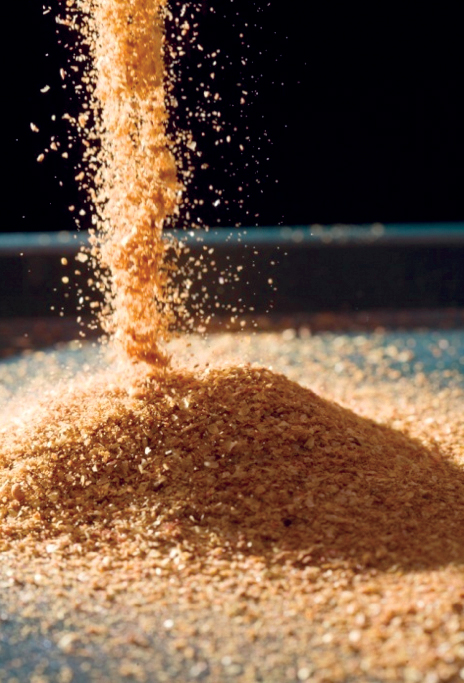
Aquafeeds
A look at corn distillers dried grains with solubles
Corn distillers dried grains with solubles are an economical source of energy, protein and digestible phosphorus to reduce feed costs and fishmeal usage.
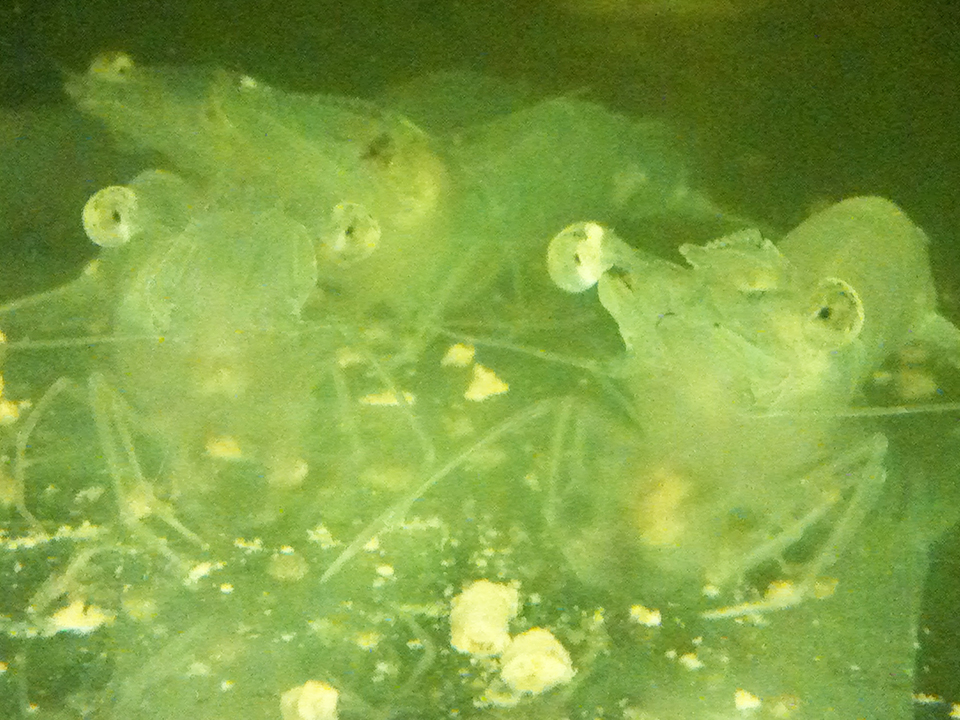
Aquafeeds
Soybean meal, distillers grains replace fishmeal in experimental shrimp diets
A study that used DDGS to partially replace soybean meal as the primary protein source in diets for juvenile white shrimp found the growth of shrimp significantly decreased when DDGS replaced soybean meal.
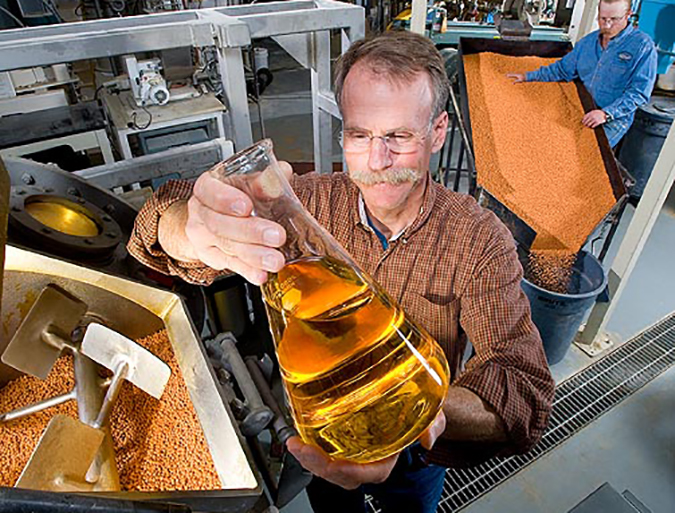
Aquafeeds
Aquaculture Exchange: Rick Barrows
After 14 years with the USDA’s Agricultural Research Service, Rick Barrows talks about the importance of finding ‘complete’ and commercially viable alternative sources of omega-3 fatty acids and continuing innovation in the aquafeed sector.

Innovation & Investment
Artemia, the ‘magic powder’ fueling a multi-billion-dollar industry
Artemia, microscopic brine shrimp used as feed in hatcheries, are the unsung heroes of aquaculture. Experts say artemia is still inspiring innovation more than 50 years after initial commercialization. These creatures are much more than Sea-Monkeys.


